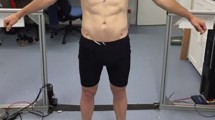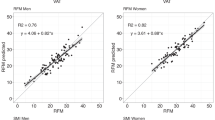Abstract
Background
Body image scanners are used in industry and research to reliably provide a wealth of anthropometric measurements within seconds. The demonstrated utility of the scanners drives the current proliferation of more commercially available devices that rely on their own reference body sites and proprietary algorithms to output anthropometric measurements. Since each scanner relies on its own algorithms, measurements obtained from different scanners cannot directly be combined or compared.
Objectives
To develop mathematical models that translate anthropometric measurements between the three popular commercially available scanners.
Methods
A unique database that contained 3D scanner measurements in the same individuals from three different scanners (Styku, Human Solutions, and Fit3D) was used to develop linear regression models that translate anthropometric measurements between each scanner. A limits of agreement analysis was performed between Fit3D and Styku against Human Solutions measurements and the coefficient of determination, bias, and 95% confidence interval were calculated. The models were then applied to normalized scanner data from four different studies to compare the results of a k-means cluster analysis between studies. A scree plot was used to determine the optimal number of clusters derived from each study.
Results
Correlations ranged between R2 = 0.63 (Styku and Human Solutions mid-thigh circumference) to R2 = 0.97 (Human Solutions and Fit3D neck circumference). In general, Fit3D had better agreement with Human Solutions compared to Styku. The widest disagreement was found in chest circumference (Fit3D (bias = 2.30, 95% CI = [−3.83, 8.43]) and Styku (bias = −5.60, 95% CI = [−10.98, −0.22]). The optimal number of body shape clusters in each of the four studies was consistently 5.
Conclusions
The newly developed models that translate measurements between the scanners Styku and Fit3D to predict Human Solutions measurements make it possible to standardize data between scanners allowing for data pooling and comparison.
This is a preview of subscription content, access via your institution
Access options
Subscribe to this journal
Receive 12 print issues and online access
$259.00 per year
only $21.58 per issue
Buy this article
- Purchase on Springer Link
- Instant access to full article PDF
Prices may be subject to local taxes which are calculated during checkout




Similar content being viewed by others
Data availability
Data will be made available by request after review by the United States Military Academy Chief Data Officer, Paul Evangelista. The review will determine the risks to personnel for data sharing and is dependent on the type of request. Requests can be made at paul.evangelista@westpoint.edu.
References
Istook CL 5 - Three-dimensional body scanning to improve fit. In: Fairhurst C (ed) Advances in Apparel Production. Woodhead Publishing, 2008, pp 94–116.
Derouchey JD, Tomkinson GR, Rhoades JL, Fitzgerald JS. Reliability of the Styku 3D whole-body scanner for the assessment of body size in athletes. Meas Phys Educ Exerc Sci. 2020;24:228–34. https://doi.org/10.1080/1091367X.2020.1791124.
Morse S, Talty K, Kuiper P, Scioletti M, Heymsfield SB, Atkinson RL, et al. Machine learning prediction of combat basic training injury from 3D body shape images. PLoS One. 2020;15:e0235017. https://doi.org/10.1371/journal.pone.0235017.
Harty PS, Sieglinger B, Heymsfield SB, Shepherd JA, Bruner D, Stratton MT, et al. Novel body fat estimation using machine learning and 3-dimensional optical imaging. Eur J Clin Nutr. 2020;74:842–5. https://doi.org/10.1038/s41430-020-0603-x.
Sobhiyeh S, Borel N, Dechenaud M, Graham CA, Wong M, Wolenski P, et al. Fully automated pipeline for body composition estimation from 3D optical scans using principal component analysis: a shape up study. Annu Int Conf IEEE Eng Med Biol Soc IEEE Eng Med Biol Soc Annu Int Conf. 2020;2020:1853–8. https://doi.org/10.1109/embc44109.2020.9175211.
Bennett JP, Liu YE, Quon BK, Kelly NN, Leong LT, Wong MC, et al. Three-dimensional optical body shape and features improve prediction of metabolic disease risk in a diverse sample of adults. Obes (Silver Spring, Md). 2022;30:1589–98. https://doi.org/10.1002/oby.23470.
Sobhiyeh S, Kennedy S, Dunkel A, Dechenaud ME, Weston JA, Shepherd J, et al. Digital anthropometry for body circumference measurements: toward the development of universal three-dimensional optical system analysis software. Obes Sci Pr. 2021;7:35–44. https://doi.org/10.1002/osp4.467.
Rhoades H. U.S. Army to evaluate relationship between body composition and physical fitness. US Army, 2021. https://www.tradoc.army.mil/2021/10/19/u-s-army-to-evaluate-relationship-between-body-composition-and-physical-fitness/.
Watts K, Hwaung P, Grymes J, Cottam SH, Heymsfield SB, Thomas DM. Allometric models of adult regional body lengths and circumferences to height: insights from a three-dimensional body image scanner. Am J Hum Biol: Off J Hum Biol Counc. 2020;32:e23349. https://doi.org/10.1002/ajhb.23349.
Tinsley GM, Moore ML, Dellinger JR, Adamson BT, Benavides ML. Digital anthropometry via three-dimensional optical scanning: evaluation of four commercially available systems. Eur J Clin Nutr. 2020;74:1054–64. https://doi.org/10.1038/s41430-019-0526-6.
Heymsfield SB, Smith B, Wong M, Bennett J, Ebbeling C, Wong JMW, et al. Multicomponent density models for body composition: Review of the dual energy X-ray absorptiometry volume approach. Obes Rev. 2021;22:e13274. https://doi.org/10.1111/obr.13274.
Bennett JP, Liu YE, Quon BK, Kelly NN, Wong MC, Kennedy SF, et al. Assessment of clinical measures of total and regional body composition from a commercial 3-dimensional optical body scanner. Clin Nutr (Edinb, Scotl). 2022;41:211–8. https://doi.org/10.1016/j.clnu.2021.11.031.
Thomas DM, Galbreath D, Boucher M, Watts K. Revisiting Leonardo da Vinci’s Vitruvian man using contemporary measurements. Jama. 2020;323:2342–3. https://doi.org/10.1001/jama.2020.3501.
Bland JM, Altman DG. Measuring agreement in method comparison studies. Stat Methods Med Res. 1999;8:135–60. https://doi.org/10.1177/096228029900800204.
James G. An introduction to statistical learning with applications in R. In: Witten D, Hastie T, Tibshirani R, (eds). 2nd ed. ed. New York: Springer %J Springer Texts in Statistics Ser. 2021. https://books.google.com/books/about/An_Introduction_to_Statistical_Learning.html?id=qcI_AAAAQBAJ.
Löffler-Wirth H, Willscher E, Ahnert P, Wirkner K, Engel C, Loeffler M, et al. Novel anthropometry based on 3D-bodyscans applied to a large population based cohort. PLoS One. 2016;11:e0159887. https://doi.org/10.1371/journal.pone.0159887.
Thoma ME, Hediger ML, Sundaram R, Stanford JB, Peterson CM, Croughan MS, et al. Comparing apples and pears: women’s perceptions of their body size and shape. J Women’s Health (Larchmt). 2012;21:1074–81. https://doi.org/10.1089/jwh.2012.3634.
Lebovitz HE. The relationship of obesity to the metabolic syndrome. Int J Clin Pract. 2003: 18–27. https://pubmed.ncbi.nlm.nih.gov/12793594/.
Maessen MF, Eijsvogels TM, Verheggen RJ, Hopman MT, Verbeek AL, de Vegt F. Entering a new era of body indices: the feasibility of a body shape index and body roundness index to identify cardiovascular health status. PLoS One. 2014;9:e107212. https://doi.org/10.1371/journal.pone.0107212.
Pleuss JD, Talty K, Morse S, Kuiper P, Scioletti M, Heymsfield SB, et al. A machine learning approach relating 3D body scans to body composition in humans. Eur J Clin Nutr. 2019;73:200–8. https://doi.org/10.1038/s41430-018-0337-1.
Frenzel A, Binder H, Walter N, Wirkner K, Loeffler M, Loeffler-Wirth H. The aging human body shape. NPJ Aging Mech Dis. 2020;6:5 https://doi.org/10.1038/s41514-020-0043-9.
Funding
MS and DMT were funded by NIH U54TR004279.
Author information
Authors and Affiliations
Contributions
DMT, MS, MM, and NA conceived this study. JS, NG and SBH provided data and data interpretation for this study. NA performed the statistical analysis under supervision from DMT, MS, and DR. DMT and NA prepared the first draft of the manuscript. MM, BB, and BAS provided insight into US Army problems with different scanners. All authors reviewed multiple drafts of the manuscript.
Corresponding author
Ethics declarations
Competing interests
The US Military Academy has no affiliation with any industry and DMT, NA, DR, and MS have no conflicts of interest or financial disclosures. also have no conflicts of interest or financial disclosures. JS has an investigator initiated grant with Hologic. JS is on the scientific advisory board for Styku and Hologic. JS has some stock options for being on the boards of Styku and formerly on BodySpec (value < $10k). Steven B. Heymsfield reports his role on the Medical Advisory Boards of Tanita Corporation, Amgen, and Medifast; he is also an Amazon Scholar.
Additional information
Publisher’s note Springer Nature remains neutral with regard to jurisdictional claims in published maps and institutional affiliations.
Supplementary information
Rights and permissions
About this article
Cite this article
Ashby, N., Jake LaPorte, G., Richardson, D. et al. Translating digital anthropometry measurements obtained from different 3D body image scanners. Eur J Clin Nutr 77, 872–880 (2023). https://doi.org/10.1038/s41430-023-01289-5
Received:
Revised:
Accepted:
Published:
Issue Date:
DOI: https://doi.org/10.1038/s41430-023-01289-5
This article is cited by
-
Mobile phone applications for 3-dimensional scanning and digital anthropometry: a precision comparison with traditional scanners
European Journal of Clinical Nutrition (2024)



